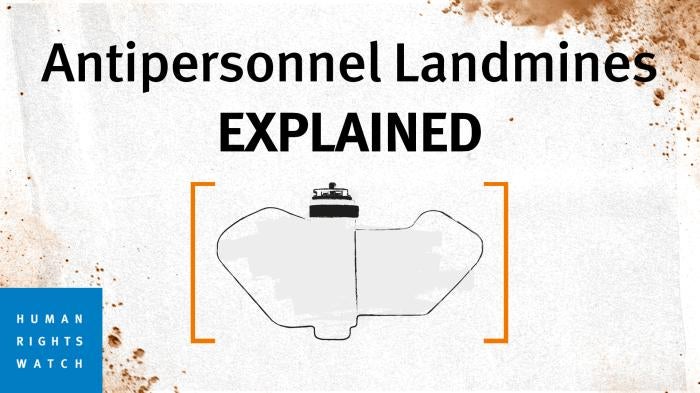The international treaty banning antipersonnel landmines risks being undermined by new use by countries such as Russia and Myanmar that are not parties, Human Rights Watch said today in releasing the Landmine Monitor 2024 report.
The 142-page report will be presented at the Mine Ban Treaty's Fifth Review Conference in Siem Reap, Cambodia, on November 25 to 29, 2024, which approximately 100 countries are expected to attend.
"The Mine Ban Treaty's positive impact can be seen in the drop in the production of antipersonnel mines, the virtual end to transfers of these weapons, and the destruction of more than 55 million stockpiled mines," said Mark Hiznay, associate arms director at Human Rights Watch and an editor of Landmine Monitor 2024. "However, new use of antipersonnel mines by countries that have not joined threatens both civilian lives and the effectiveness of this life-saving treaty."
The 1997 Mine Ban Treaty, which entered into force on March 1, 1999, has made significant progress since it took effect 25 years ago. The treaty comprehensively prohibits antipersonnel mines and requires countries to destroy stockpiles, clear mine-affected areas, and assist victims.
A total of 164 countries have joined the treaty, including all NATO members except the United States. The United States is not a member, but in June 2022, President Joe Biden set the US goal of ultimately joining the treaty and realigned US policy with most of the treaty's core prohibitions. In January 2020, then-president and current President-elect Donald Trump canceled a policy that would have eliminated all antipersonnel mines in the US arsenal.

Antipersonnel mines kill and wound people indiscriminately. They are typically placed by hand, but they can also be scattered by aircraft, rockets, and artillery or dispersed from specialized vehicles. Uncleared landmines pose a danger until cleared and destroyed. Mined land can drive displacement of the civilian population, hinder the delivery of humanitarian aid, and prevent agricultural activities.
Russia has used antipersonnel landmines repeatedly in Ukraine since its full-scale invasion of the country on February 24, 2022, leading to hundreds of casualties and vast tracts of contaminated land. Ukrainian officials are investigating reports that their forces used PFM antipersonnel mines in and around the city of Izium during 2022, when it was occupied by Russian forces.
The Myanmar junta's armed forces have used antipersonnel landmines continuously since 1999. Myanmar tops the Landmine Monitor's list of countries with the highest number of annual casualties for the first time, with the report recording that antipersonnel mines killed or wounded 1,003 people in 2023 in the country. Previously, Syria had the highest number of annual casualties for three consecutive years.
Reports indicate that the Iranian government's Islamic Revolutionary Guard Corps and North Korea also used antipersonnel mines during 2023 and the first half of 2024.
Non-state armed groups used mostly improvised antipersonnel mines in at least five countries-Colombia, India, Myanmar, Pakistan, and Palestine (Gaza)-during 2023 and the first half of 2024, as well as in the Sahel region of Africa. In Gaza, the Izz al-Din al-Qassam Brigades, the armed wing of Hamas, has said numerous times that its fighters have used antipersonnel mines since October 7, 2023. The Mine Ban Treaty prohibits all victim-activated explosive devices regardless of whether they were improvised from locally available materials or manufactured in a factory.
There were at least 5,757 new casualties from landmines and explosive remnants of war in 53 countries and 2 other areas in 2023, including 1,983 deaths. Civilians made up 84 percent of all recorded casualties in 2023, while children were 37 percent of casualties when the age was recorded.
A total of 281.5 kilometers of contaminated land was cleared in 2023, the largest area cleared by states parties since 2019, and 160,566 antipersonnel mines were destroyed. Under the treaty, 33 states have completed the clearance of all antipersonnel mines from their territory since 1999.
Ninety-four states parties have collectively destroyed more than 55 million landmines from their stockpiles. In 2021, Sri Lanka became the last state party to complete the destruction of its stocks. Ukraine and Greece are the only states parties with landmine stocks left to destroy.
In 2023, global support for mine action including mine clearance and victim assistance totaled US$1.03 billion, the first time that annual funding for mine action has surpassed $1 billion. The increase largely reflects an influx of donations to Ukraine, which topped the list of recipients in 2023 for the second year in a row, receiving $308 million.
"Clearing landmines is a critical task, as are measures to meet the life-long needs of landmine survivors," Hiznay said. "Governments should ensure that adequate resources are available to all countries needing assistance so that the treaty's humanitarian goals are achieved."
The "Landmine Monitor 2024" is a publication by the International Campaign to Ban Landmines, the global coalition of nongovernmental organizations that received the 1997 Nobel Peace Prize. Human Rights Watch co-founded the campaign in 1992 and contributes to its Landmine Monitor reporting initiative.







